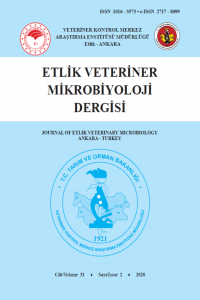Sığırlarda Trichophytosis’in Teşhisinde ELISA’nın Kullanılabilirliğinin Araştırılması
Öz
Trichophytosis, bütün dünyada hayvancılık sektöründe ekonomik kayıplara neden olan ve derinin epitelyum tabakasının keratinize olarak kalınlaşması ve kılların dökülmesiyle karakterize olan bulaşıcı bir dermatomikozistir. Ancak trichophytosis gerek diğer mantar enfeksiyonları ve gerekse başka enfeksiyöz ve nonenfeksiyöz deri hastalıkları ile karışabilmektedir. Kesin teşhis yapılmadan tedavi uygulaması ise hem ekonomik kayba neden olmakta hem de gerçek enfeksiyonun tedavisi yapılamamaktadır. Bu amaçla Trichophyton verrucosum ile enfekte olan sığırların tedavisi için kesin tanı önem taşımaktadır. Bu çalışmada, trichophytosisin serolojik teşhisinde ELISA’nın kullanılabilirliğinin belirlenmesi amaçlanmıştır. Bu çalışmada geliştirilen Enzyme-Linked Immunosorbent Assay (ELISA) ile tanısal duyarlılık %95.24 ve tanısal özgüllük %100 olarak bulundu. Şanlıurfa ve civarında daha önce hastalık tespit edilen 4 sığır sürüsündeki sığırlardan alınan kan serumları Enzyme-Linked Immunosorbent Assay (ELISA) ile test edildi. Buna göre toplam 360 sığır serumu örneğinin 289’u (%80.3) pozitif bulundu. Sonuç olarak Enzyme-Linked Immunosorbent Assay (ELISA)’nın; tanıda kullanılan izolasyon yöntemi uzun süre aldığından, kısa sürede teşhis yapabilecek bir tanı yöntemi olduğu ve bu bağlamda hastalığın teşhisine büyük oranda katkı sağlayacağı kanısına varıldı. Ayrıca çalışmada elde edilen yüksek seropositivite oranı, serumlar her ne kadar daha önce hastalık görülen çiftliklerden alınmış olsa da, yine de hastalığın bölgede yaygın olduğunu ve gerekli kontrol önlemlerinin alınmasının önemli olduğunu göstermektedir.
Anahtar Kelimeler
Destekleyen Kurum
Harran Üniversitesi Bilimsel Araştırma Projeleri Koordinatörlüğü
Proje Numarası
17055
Teşekkür
Harran Üniversitesi Bilimsel Araştırma Projeleri Koordinatörlüğü
Kaynakça
- Arda M. (2000) Temel Mikrobiyoloji. 2. Baskı. Ankara: Medisan Yayınevi, s.315-367.
- Băguţ ET, Cambier L, Heinen MP, Cozma V, Monod M, Mignon B. (2013) Development of an Enzyme-Linked Immunosorbent Assay for Serodiagnosis of Ringworm Infection in Cattle. Clin Vaccine Immunol. 20(8), 1150-1154.
- Biberstein EL, Hirsh DC. (2004) Dermatophytes. In: Hirsh DC, MacLachlan NJ, Walker RL, eds. Veterinary Microbiology. Oxford: Blackwell Publishing Co. 273-284.
- Brouta F, Descamps F, Vermout S, Monodi M, Losson B. (2003) Humoral and cellular immune response to a Microsporum canis recombinant keratinolytic metalloprotease (r-MEP3) in experimentally infected guinea pigs. Med. Mycol. 41, 495-501.
- Carlsson J. (1993) Risken for ringworm hos notkreatur och miinniska. Sven Vet Tidn. 45,467-471.
- Çenesiz S, Cevat N, Yarım GF, Arslan HH, Çiftçi A. (2007) Trikofitozisli ineklerde serum adenozin deaminaz aktivitesi (ADA) ve nitrik oksit (NO) düzeyleri. Ankara Üniv Vet Fak Derg. 54, 155-158.
- Davidov I, Radinovig M, Kovacevig Z, Erdeljan M, Galfi A, Iliğ S. (2018) Trichophytosis In Beef Cattle. VJRS. 18(2), 428-445.
- Deacon JW. (1988) Introduction to modern mycology. 2nd ed. Oxford: Blackwell Scientific Publications. 1-239.
- Elad D, Segal E. (1995) Immunogenicity in calves of a crude ribosomal fraction of Trichophyton verrucosum: a field trial. J Vacc. 13(1), 83-87.
- Gudding R, Lund A. (1995) Immunoprophylaxis of bovine dermatophytosis. Can. Vet. J. 36, 302-306.
- Haab C. (1991) Epidemiologie der Trichophytie beim Mastkalb (Inaugural Dissertation). Switzerland, Zurich: University of Zurich. p.77.
- Kane J, Smitka C. (1978) Early Detection and Identification of Trichophyton verrucosum. J Clin Microbiol. 8(6), 740-7.
- Kiraz M. (1988) Dermatofitlerin tür tanısı ve antibiyotiklere duyarlılıkları. Doktora tezi, İÜ Sağlık Bilimleri Enstitüsü, İstanbul.
- Mikaili A, Chabili M, Ghashghaie A, Mostafaie A. (2012) Immunization against bovine dermatophytosis with live Trichophyton verrucosum. Afr. J Microbiol Res. 6(23), 4950-4953.
- Morrell J, Stratman E. (2011) Primary Care and Specialty Care Delays in Diagnosing Infection Related to Cattle Exposure. J Agromedicine. 16(4), 244-250.
- Papini R, Nadoni S, Fanelli A, Mancianti F. (2009) High Infection Rate of Trichophyton verrucosum in Calves from Central Italy. Zoonoses Public Health. 56(2), 59–64.
- Peano A, Rambozzi L, Gallo MG. (2005) Development of an enzyme-linked immunosorbant assay (ELISA) for he seradiagnosis of canine dermatophytosis caused by Microsporum canis. Vet Dermatol. 16, 102-107.
- Rybnikár˘ A, Oborilova E. (2007) Clinical assessment of postinfection, postcontact and postvaccination immunity manifestation after experimental inoculation of calves with Trichophyton verrucosum culture. Mycoses. 51, 236–242.
- Santana AE, Taborda CP, Severo JS, Rittner GMG, Munoz JE, Larsson Jr CE. (2018) Development of enzyme immunoassays (ELISA and Western blot) for he serological diagnosis of dermatophytosis in symptomatic and asymptomatic cats. Med Mycol. 56, 95-102.
- Sayfarth F, Roediger C, Graser Y, Erhard M, Burmester A, Elsner P. (2011) Case report: Trichophyton verrucosum infection after needlestick injury with an attenuated live vaccine against cattle ringworm. Mycoses. 54(6), 870–876.
- Simpanya MF. (2000) Dermatophytes: Their taxonomy, ecology and pathogenicity. In: Biology of Dermatophytes and other Keratinophilic Fungi. Rev Iberoam Mıcol. p.1-12.
- Tel OY. (2005). Kedi ve köpeklerden dermatofitlerin izolasyonu. Doktora Tezi, AÜ Sağlık Bilimleri Enstitüsü, Ankara.
- Thomas JW, Hayden RT, Larone DH. (2018) Larone’s Medically Important Fungi: A Guide to Identification. 6, 270-280. Weber A. (2000) Mycozoonoses with special regard to ringworm of cattle. Mycoses. 43(1), 20-22.
- Zahran RN, Eman AA. (2013) Evaluation Of The Immune Response To T. verrucosum Vaccines. Am J Immunol. 9 (4),139-147.
- Zrimsek P, Drobnic-Kosorok M. (2002) Diagnostic Value of ELISA Tests for he Detection of Specific Antibodies in Cats and Rabbits with Dermatophytosis. J Biotechnol. 40(3), 171-175.
- Zrimsek P, Kos J, Pinter L, Drobnic-Kosorok M. (1999) Detection by ELISA of the humoral immune response in rabbits naturally infected with Trichophyton mentagrophytes. Vet Microbiol. 70(1-2), 77-86.
Ayrıntılar
| Birincil Dil | Türkçe |
|---|---|
| Konular | Veteriner Bilimleri |
| Bölüm | Araştırma Makaleleri |
| Yazarlar | |
| Proje Numarası | 17055 |
| Yayımlanma Tarihi | 31 Aralık 2020 |
| Gönderilme Tarihi | 17 Temmuz 2020 |
| Yayımlandığı Sayı | Yıl 2020 Cilt: 31 Sayı: 2 |

